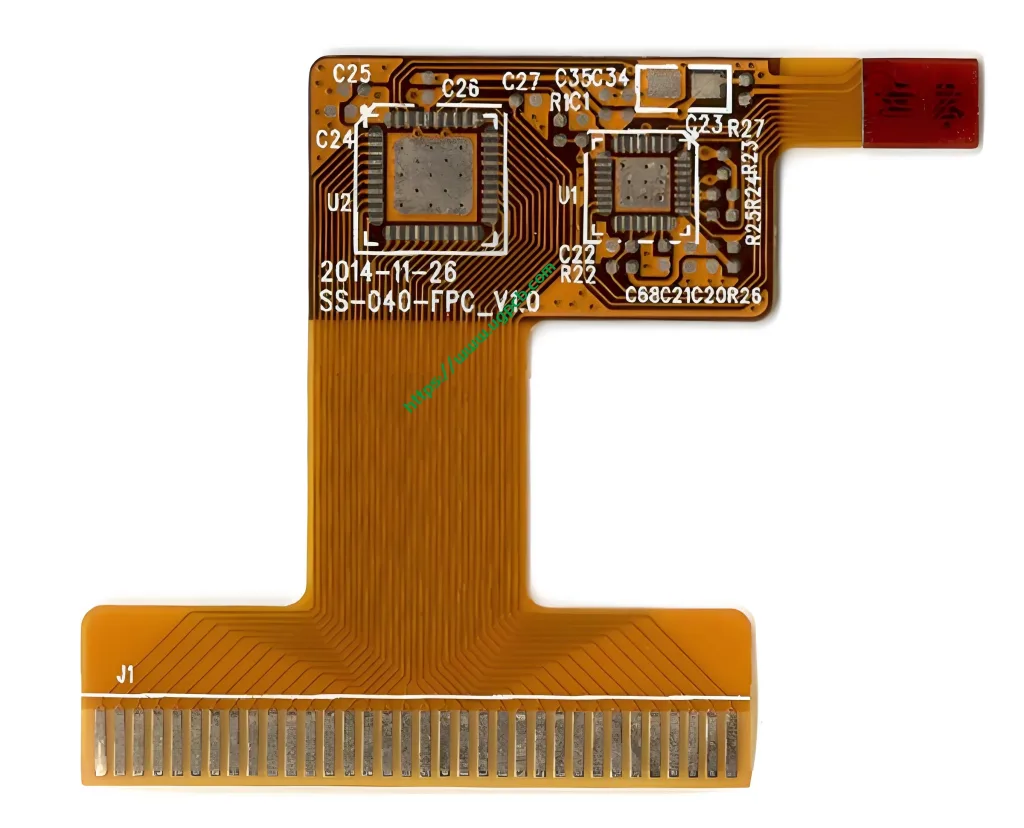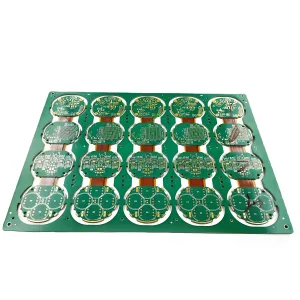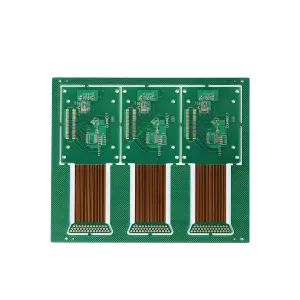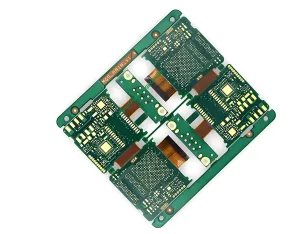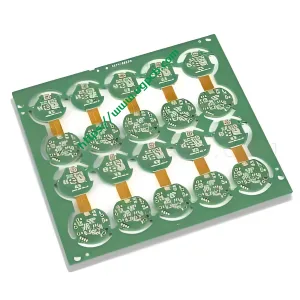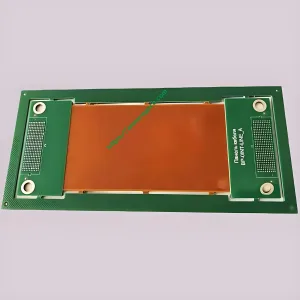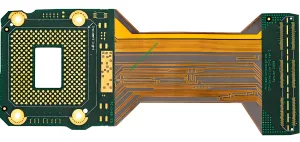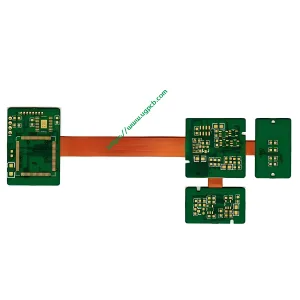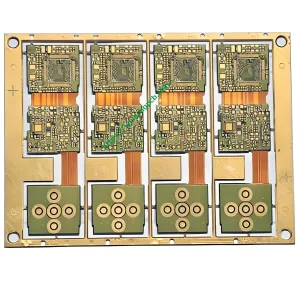FPC è anche chiamato PCB flessibile o circuito stampato flessibile. FPC è realizzato in poliimide (PI) o polietilene tereftalato (ANIMALE DOMESTICO) Materiale PCB flessibile che può essere piegato e piegato. FPC è un circuito flessibile con alta densità di circuiti, leggero, spessore sottile, e buone prestazioni di piegatura.
FPC è un metodo per soddisfare i requisiti di miniaturizzazione e mobilità dei prodotti elettronici. La scheda PCB flessibile può essere piegata, ferita, e piegato liberamente, può resistere a milioni di flessioni dinamiche senza danneggiare il conduttore, può essere organizzato arbitrariamente in base ai requisiti di layout spaziale, e può muoversi ed espandersi liberamente nello spazio tridimensionale, in modo da ottenere l'integrazione del gruppo PCB e della connessione del conduttore. Il prototipo FPC presenta anche i vantaggi della buona dissipazione del calore, saldabilità, Assemblaggio facile, e basso costo completo. Perciò, Il substrato flessibile è stato ampiamente utilizzato nella striscia LED flessibile, aerospaziale, militare, comunicazione mobile, computer portatile, periferiche del computer, PDA, fotocamere digitali, e altri campi o prodotti. Cos'è FPC? Sai?
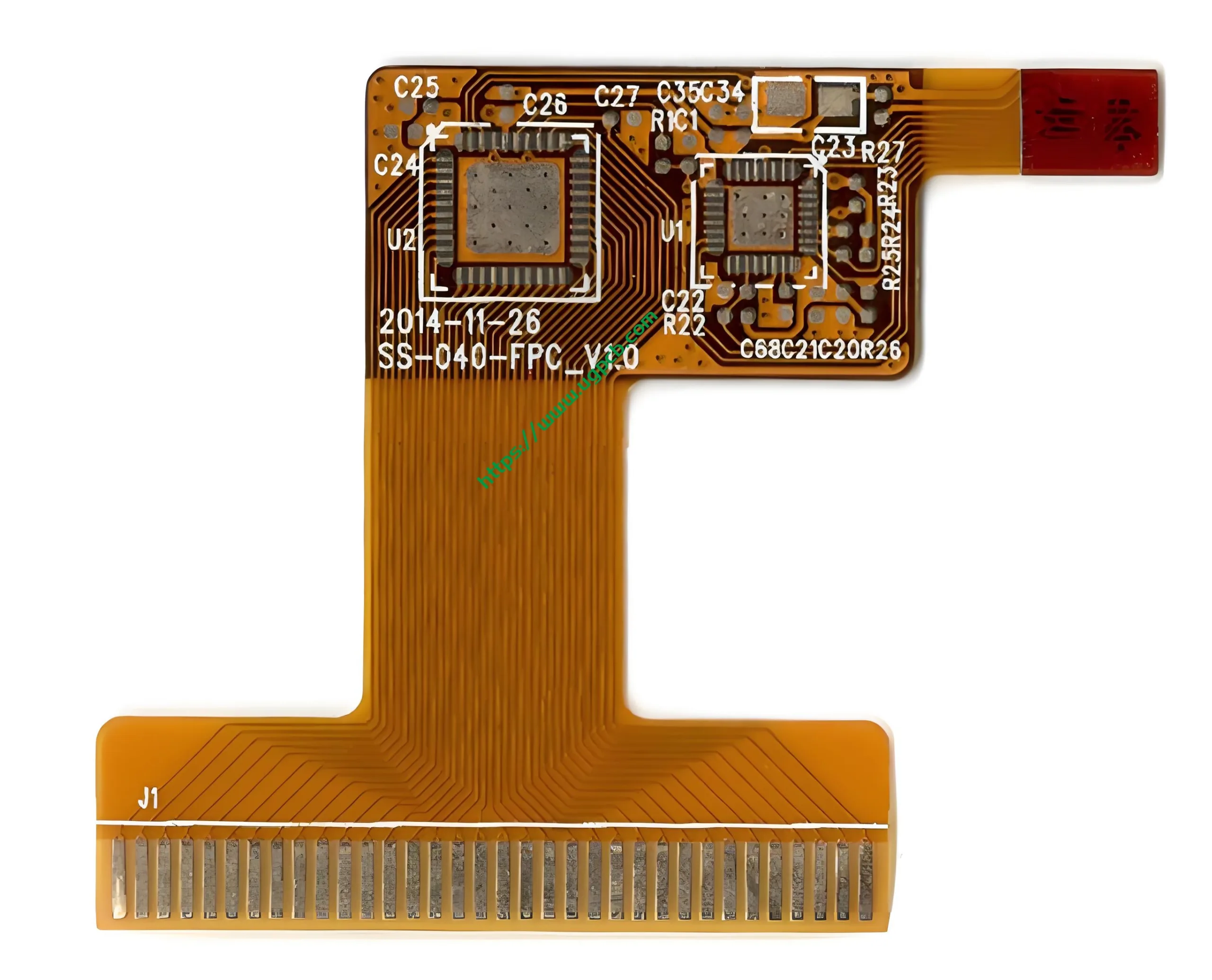
Qual è la differenza tra PCB vs FPC?
1. PCB è realizzato dalla stampa, Quindi si chiama circuito stampato. FPC è anche realizzato dalla stampa, Quindi il circuito flessibile FPC è anche un circuito stampato PCB. I circuiti stampati includono PCB rigido e substrato flessibile. Ma siamo abituati a riferirci a schede PCB rigide come PCB o PCB, La scheda PCB flessibile si chiama FPC o FPCB.
2. Il PCB flessibile e l'utilizzo dello spazio PCB rigido sono diversi. Per circuiti rigidi PCB, A meno che le linee non vengano realizzate in forma tridimensionale dalla colla del film, Il circuito è piatto in generale. Perciò, Il design dei prodotti elettronici dovrebbe sfruttare appieno lo spazio tridimensionale, e il circuito flessibile FPC è una buona soluzione. Lo schema di estensione spaziale comune per i circuiti rigidi PCB consiste nell'utilizzare le schede di interfaccia slot più. I circuiti flessibili FPC possono realizzare strutture simili purché siano progettate per mezzo di trasferimento, e hanno una maggiore flessibilità nel design direzionale.
3. Circuito flessibile PCB e circuito PCB rigido hanno caratteristiche diverse. FPC generalmente utilizza PI o PET come materiale del substrato flessibile di base e può piegarsi o flettersi liberamente. PWB è generalmente fatto di FR4, ceramica, Teflon, e metallo, che non può essere piegato o flesso.
4. PCB a circuito flessibile e PCB a circuito rigido vengono utilizzati per scopi diversi. La scheda flessibile FPC viene utilizzata su collegamenti che richiedono piegatura ripetuta e alcuni widget. La scheda rigida PCB viene spesso utilizzata in luoghi in cui la flessione non è necessaria e dove la durezza è relativamente alta.
FPC vs PCB
Sette tipi di substrato flessibili
1. La scheda PCB flessibile a lato singolo è composta da “circuito a singolo lato + film protettivo”. La piastra flessibile a singolo lato ha una buona resistenza pieghevole.
2. La scheda PCB flessibile a doppia faccia è composta da “film protettivo + Circuito a doppia faccia + film protettivo”. La scheda flessibile a doppia faccia ha un foglio di rame su entrambi i lati del substrato a doppia faccia, e gli strati superiori e inferiori sono collegati attraverso i fori PTH, Quindi la sua flessibilità è peggiore di quella del singolo pannello.
3. La scheda FPC a singolo singolo composito singolo è composta da “film protettivo + single laterale + colla pura + single laterale + film protettivo”. È per attaccare due fogli di rame singolo insieme a pura colla e quindi condurre i due strati attraverso i fori PTH, e la colla pura nell'area di flessione deve essere scavata.
4. La scheda FPC in rilievo è composta da “pura foglio di rame + Film di protezione superiore e inferiore”. Il foglio di rame puro più spesso viene premuto sul PI, e la struttura delle dita sospese si forma in alcune aree. È usato principalmente nella crimpatura del display di cristalli liquidi (Tft) e può fornire la funzione plug-in della saldatura densa.
5. PCB multistrato flessibile, PCB multistrato flessibile è fatto “CCL a faccia singola multipla (o schede a doppia faccia) + colla pura + film protettivo (Cvl)”. I fili di ogni strato sono collegati attraverso i fori PTH. A causa di troppi strati, La sua flessibilità è scarsa (La flessibilità dell'area di progettazione dell'apertura della pura colla è buona)
6. Il PCB resistente a flessione è saldato o premuto da “substrato FPC a lato singolo o a doppia faccia + substrato PCB rigido multistrato “. Le linee sulla scheda PCB resistenti flessibili sono collegate attraverso i fori PTH. La scheda PCB resistente a Flex può realizzare l'assemblaggio tridimensionale in diverse condizioni di montaggio, ha le caratteristiche della luce, sottile e corto, e può ridurre la dimensione del montaggio, qualità, e errori di cablaggio dei prodotti elettronici.
7. L'antenna PCB flessibile equivale a estrarre la linea dell'antenna sul PCB e utilizzando altri metalli esterni come antenna. Di solito viene utilizzato in telefoni cellulari di fascia media e di fascia bassa e prodotti hardware intelligenti con bande di frequenza complesse. Questa antenna a circuito flessibile è applicabile a quasi tutti i piccoli prodotti elettronici e può essere utilizzata come antenna complessa in più di 10 bande di frequenza come 4G. Ha buone prestazioni e basso costo.
Come realizzare PCB flessibile?
2 Processo di produzione PCB flessibile a livello
Taglio – perforazione – PTH – elettroplazione – pretrattamento – Incolla film asciutto – allineamento – esposizione – sviluppo – Elettroplaggio grafico – Rimozione del film – pretrattamento – Incolla film asciutto – esposizione all'allineamento – sviluppo – Incisione – Rimozione del film – Trattamento superficiale – pasta che copre il film – premendo – polimerizzazione – deposizione di nichel – Stampa del personaggio – taglio – misurazione elettrica – pugni – ispezione finale – confezione – spedizione
1 Processo di produzione PCB flessibile a livello
Taglio – perforazione – Film secco – allineamento – esposizione – sviluppo – Incisione – stripping – Trattamento superficiale – Film di copertura attaccante – premendo – polimerizzazione – Trattamento superficiale – deposizione d'oro in nichel – Stampa del personaggio – taglio – misurazione elettrica – pugni – ispezione finale – confezione – spedizione
Come saldare FPC a PCB e come cancellare il PCB flessibile?
Il PCB flessibile di saldatura deve utilizzare un connettore FPC per connettersi con PCB, Quindi appare il PCB rigido-flex. Il PCB rigido-flex può risparmiare il costo del connettore del connettore FPC a PCB e FPC. Ha anche un migliore utilizzo dello spazio e prestazioni più stabili. Tuttavia, Il costo del PCB rigido-flex è molto più alto di quello del PCB flessibile.
La macchina PCB flessibile per la pulizia ionica può risolvere il problema della scarsa idrofilia di FPC e della scarsa adesione della placcatura di rame. La scarsa idrofilia di PI, Un materiale PCB flessibile, è la ragione fondamentale che riguarda l'affidabilità della placcatura del rame. Il trattamento superficiale del substrato PI da parte della pulizia del plasma può migliorare efficacemente l'idrofilia del materiale PI, Il misuratore dell'angolo di contatto dell'acqua viene utilizzato per misurare il materiale PI prima e dopo il trattamento della superficie plasmatica. L'angolo di contatto con l'acqua può essere ridotto da più di 450 a meno di 50. Se il rivestimento di sputtering magnetron viene eseguito in questo momento, La forza di legame del film in rame può soddisfare i requisiti previsti.
A volte, per la saldatura FPC, Perché è troppo morbido, Dobbiamo progettare un rinforzo per questo. Il rinforzo FPC è generalmente realizzato da PCB flessibile Altium. Quando dobbiamo saldare i componenti a FPC, Progettare il substrato flessibile si collega da PCB in alluminio flessibile a circuito PCB. Può fare in modo che il porto di produzione del circuito fpc abbia una migliore durezza. Questo lo rende più conveniente.
Caratteristiche di FPC
Gli FPC hanno flessibilità e affidabilità. Attualmente, Esistono quattro tipi di schede PCB flessibili FPC: a faccia singola, a doppia faccia, multistrato, e PCB a flessione flessibile.
1. L'FPC a faccia singola è il meno costoso quando non richiedono alte prestazioni elettriche. Quando si cabing di circuiti PCB a faccia singola, Le schede flessibili unilaterali devono essere selezionate. Ha un modello conduttivo inciso chimico e un foglio di rame calendario come strato di motivo conduttivo sul materiale di base isolante flessibile. I materiali isolanti possono essere poliimmide, polietilene tereftalato, estere in fibra di acrilamide, e polivinil cloruro.
2. L'FPC a doppia faccia è un grafico conduttivo realizzato con un strato su ciascun lato della membrana di base di isolamento. I fori metallizzati collegano la grafica su entrambi i lati del materiale isolante per formare percorsi conduttivi per soddisfare la progettazione di flessibilità e funzioni utili. Il coperchio protegge i fili singoli e a doppia faccia e indica dove vengono posizionati i componenti.
3. Il circuito multistrato FPC è strati di circuiti flessibili unilaterali o bilaterali con tre o più strati, e i fori metallizzati sono formati perforando LS ed elettroplando per formare percorsi conduttivi tra gli strati. Ciò elimina la necessità di complessi processi di saldatura. I circuiti multistrato hanno enormi differenze funzionali in maggiore affidabilità, migliore conducibilità termica, e prestazioni di montaggio più convenienti. L'interazione della dimensione dell'assemblaggio, Numero di strati, e la flessibilità dovrebbe essere presa in considerazione durante la progettazione del layout.
4. I circuiti rigidi e flessibili tradizionali sono costituiti da substrati rigidi e flessibili con strati selettivi premuti insieme. La struttura è compatta e condotta con LS metallizzato. Il PCB resistente a flessione è una buona scelta se entrambi i lati anteriori e posteriori di un circuito stampato hanno componenti. Tuttavia, Se tutti i componenti sono su un lato, Sarebbe più economico utilizzare una piastra flessibile a doppia faccia con uno strato di materiale di rinforzo FR4 sulla schiena.
5. Il circuito flessibile FPC con una struttura ibrida è un circuito PCB multistrato, e lo strato conduttivo è composto da metalli diversi. Un pannello a 8 strati utilizza FR-4 come mezzo interno e poliimide come mezzo esterno. I cavi sono estesi da tre diverse direzioni della scheda madre, ogni fatto di metalli diversi. Lega di langtang, rame, e l'oro sono usati come cavi separati. Questa struttura ibrida è utilizzata principalmente a basse temperature in cui la relazione tra conversione del segnale elettrico e conversione del calore e le prestazioni elettriche è più impegnativa ed è l'unica soluzione fattibile.
La comodità e il costo totale della progettazione interna possono essere valutati per ottenere il miglior rapporto di prezzo delle prestazioni.
L'economia di FPC
Se il design del circuito FPC è relativamente semplice, La dimensione totale è piccola, E lo spazio è adatto, La connessione interna tradizionale è per lo più molto più economica. I circuiti flessibili sono una buona opzione di progettazione per circuiti complessi, elaborazione di molti segnali, o avere proprietà elettriche o meccaniche speciali. L'assemblaggio flessibile è più economico quando le dimensioni e le prestazioni dell'applicazione superano le capacità dei circuiti rigidi. È possibile realizzare un cuscinetto da 12 mil con fori da 5mil e una linea di 3mil e un circuito flessibile di spaziatura su un singolo film. Perciò, È più affidabile montare il chip direttamente sul film. Perché non contiene ritardanti di fiamma che possono essere fonti di sporco di perforazione ionica. Questi film possono essere protettivi e curati a temperature più elevate per ottenere temperature di transizione di vetro più elevate. I risparmi sui costi di materiali flessibili rispetto ai materiali rigidi sono dovuti all'esenzione dei plug-in.
L'elevato costo delle materie prime è il motivo principale per l'alto prezzo dei circuiti flessibili. I prezzi delle materie prime variano notevolmente, e il costo delle materie prime utilizzate per il circuito flessibile in poliestere del minimo costo è 1.5 volte quello delle materie prime utilizzate per il circuito rigido. I circuiti flessibili in poliimmide ad alte prestazioni sono fino a quattro volte o più. Allo stesso tempo, La flessibilità dei materiali rende difficile automatizzare l'elaborazione durante il processo di produzione, che si traduce in una diminuzione dell'output. I difetti si verificano durante il processo di assemblaggio finale, Compreso gli attacchi flessibili e la rottura della linea. Ciò è più probabile che si verifichi quando il design non è adatto per l'applicazione. Sotto stress elevato causato dalla flessione o dalla modellatura, sono spesso richiesti materiali di rinforzo o rinforzo. Nonostante il suo alto costo di materie prime e manifatturiero ingombranti, il pieghevole, piegabile, e le funzioni di giunzione a più livelli riducono la dimensione complessiva del componente, ridurre il materiale utilizzato, e ridurre il costo complessivo dell'assemblaggio.
L'industria del circuito PCB flessibile è in procinto di suonare su piccola scala ma un rapido sviluppo. Il processo di film spesso polimerico è un processo di produzione efficiente e a basso costo. Questo processo stampa selettivamente inchiostro polimero conduttivo su substrati flessibili economici. Il materiale di base flessibile rappresentativo è PET. I conduttori di film spesso polimerico includono filler di metallo o polvere di carbonio stampati in seta. Il processo a film spesso polimerico è pulito e utilizza adesivi SMT senza piombo senza incisione. Il circuito a film spesso polimerico è un decimo del prezzo del circuito a film sottile in poliimmide in rame a causa del suo processo additivo e del basso costo del materiale di base. È 1/2-1/3 del prezzo di un circuito stampato rigido. Il metodo di pellicola spessa polimerica è particolarmente adatto per il pannello di controllo del dispositivo. Su telefoni cellulari e altri prodotti portatili, Il metodo a film spesso polimerico è adatto per la conversione dei componenti, interruttori, e dispositivi di illuminazione sulla scheda madre del circuito stampato in circuiti a filo spesso polimerico. Risparmia sia i costi che il consumo di energia.
In generale, Le schede PCB flessibili sono davvero più costose e costose dei circuiti rigidi. Le schede PCB flessibili sono prodotte con il fatto che molti parametri sono per tolleranza. La difficoltà nel creare un circuito flessibile è la flessibilità del materiale.
Fpc (Circuito stampato flessibile) è ampiamente utilizzato in diversi settori grazie alla sua eccellente flessibilità e caratteristiche sottili e leggere. Le sue principali aree di applicazione includono l'elettronica, elettronica automobilistica, Dispositivi medici e controlli industriali.
1. Elettronica
Le schede FPC sono utilizzate in una vasta gamma di prodotti elettronici, compresi i telefoni cellulari, compresse, e dispositivi indossabili intelligenti. Il loro design consente un alto grado di integrazione e può supportare connessioni a circuito miniaturizzato e ad alta densità, Migliorando così le prestazioni e la portabilità dei prodotti elettronici.
2. Elettronica automobilistica
Nel campo automobilistico, Le schede FPC sono ampiamente utilizzate per i sistemi di navigazione in auto, sistemi di intrattenimento, e dispositivi di comunicazione. Forniscono soluzioni di connettività flessibili in spazi limitati per garantire le prestazioni e la stabilità dei sistemi elettronici automobilistici.
3. Attrezzatura medica
I circuiti FPC sono sempre più utilizzati nelle attrezzature mediche, Si trova comunemente nell'attrezzatura di monitoraggio dei segni, Strumenti terapeutici e attrezzature per imaging medico. Sono in grado di mantenere l'affidabilità in ambienti ad alta temperatura e ad alta umidità e rispettare gli standard di sicurezza medica.
4. Controlli industriali
Nel campo del controllo industriale, I circuiti FPC sono utilizzati in sistemi come apparecchiature di automazione e robot per fornire cablaggi ad alta densità e connessioni affidabili. Questi consigli soddisfano la necessità di alte prestazioni e stabilità nelle moderne attrezzature industriali.
5. Aerospaziale
Le schede FPC hanno anche trovato applicazioni in aerospaziale e nell'aviazione, dove sono selezionati per la loro magrezza e elevata resistenza alle vibrazioni nelle attrezzature critiche per ridurre il peso complessivo e migliorare le prestazioni del veicolo.
Costo di FPC
Il prezzo degli assemblaggi FPC sta diminuendo, avvicinandosi a circuiti rigidi tradizionali. Il motivo principale è l'introduzione di materiali FPC aggiornati, il miglioramento del processo di produzione, e il cambiamento di struttura. Ora la struttura rende il prodotto più stabile di calore e pochi materiali non corrispondono. Alcuni materiali più recenti possono produrre linee più sofisticate perché lo strato di rame è più sottile, Rendere i componenti più leggeri e più adatti per piccoli spazi. In passato, Il foglio di rame è stato aderito ai media con rivestimento adesivo dal processo di pressione del rotolo. Oggi, Il foglio di rame può essere prodotto direttamente sui media senza usare l'adesivo. Queste tecniche provocano strati di rame spessi diversi micron, e linee sottili che sono 3m.1 o addirittura più strette di larghezza. I circuiti flessibili con alcuni adesivi rimossi hanno proprietà ritardanti di fiamma. Ciò accelererà il processo di certificazione UL e ridurrà ulteriormente i costi. Le maschere di saldatura flessibili FPC e altri rivestimenti superficiali riducono ulteriormente il costo del gruppo flessibile.
Sviluppo futuro di FPC
1. Spessore di FPC. Lo spessore di FPC sta diventando sempre più flessibile e sottile.
2. Resistenza pieghevole di FPC. È una caratteristica intrinseca di FPC che può piegarsi. La resistenza di flessione di FPC supera milioni di volte.
3. Prezzo FPC. In questa fase, Il prezzo di FPC è molto più alto di quello di PCB, e il prezzo di FPC sarà più economico in futuro.
4. Con l'aggiornamento del livello di processo FPC, L'apertura minima e la larghezza minima della linea/distanza della linea soddisfano requisiti più elevati.
In futuro, più piccolo, più complesso, E i circuiti flessibili più costosi per l'assemblaggio FPC richiederanno modi più innovativi per assemblare FPC e circuiti flessibili ibridi aggiuntivi. La sfida per l'industria del circuito flessibile è quella di sfruttare i suoi vantaggi tecnologici per tenere il passo con i computer, comunicazioni remote, domanda dei consumatori, e un mercato attivo. Inoltre, I circuiti flessibili FPC svolgeranno un ruolo importante nelle operazioni senza piombo.
Ci sono molti produttori di PCB flessibili economici in Cina che citano un prezzo flessibile per la scheda PCB. UGPCB è una società PCB flessibile professionale. Forniamo prototipo PCB flessibile e servizio PCB flessibile e offriamo PCB flessibile a basso costo. Se è necessario acquistare PCB flessibile FPC, Si prega di contattare UGPCB PCB flessibile personalizzato.
 LOGO UGPCB
LOGO UGPCB

